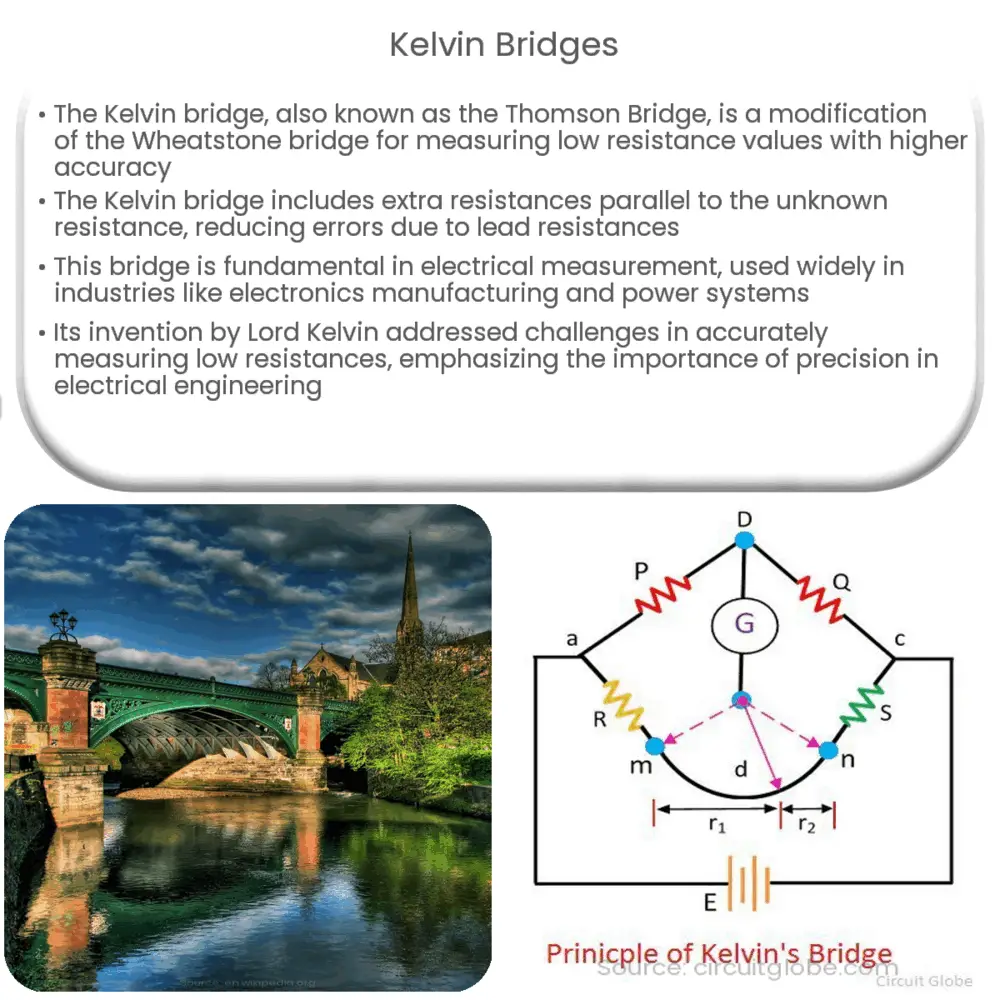Explore the Kelvin Bridge – its design, function, applications, and importance in electrical measurement and industry.

Kelvin Bridges: An Exploration
Understanding Kelvin Bridges takes us into the fascinating realm of electrical measurement and precision instrumentation. A Kelvin bridge, also known as a Thomson Bridge, is a modification of the Wheatstone bridge, named after its inventor, Lord Kelvin, otherwise known as William Thomson.
Primarily, a Kelvin bridge is used for measuring low resistance values. As resistance is one of the fundamental properties of electrical and electronic systems, accurate measurement is crucial for optimal functioning and development of these systems. Unlike other bridge systems, the Kelvin bridge provides more accurate results, especially when dealing with low resistance values.
Understanding the Basics of Kelvin Bridges
The Wheatstone bridge, the predecessor of the Kelvin bridge, is composed of four resistances configured in a diamond shape, with a source of emf (Electromotive Force) connected diagonally to the bridge and a galvanometer for detection. The principle behind its operation is the concept of balance – when the ratio of the resistances is equal, the bridge is said to be ‘balanced’ and no current flows through the galvanometer.
However, the Wheatstone bridge often struggles to accurately measure very low resistances, as lead resistances can lead to errors. Lord Kelvin proposed a solution for this problem by adding a second set of ratio arms, a design modification that became the Kelvin bridge.
The Design and Functioning of Kelvin Bridges
The Kelvin bridge adds two additional resistances to the standard Wheatstone bridge circuit. These extra resistances are connected in parallel to the unknown resistance and the galvanometer, creating an additional pathway for the current. By doing so, the effect of lead resistances is reduced, and the accuracy of low resistance measurements is significantly improved.
- The Unknown Resistance (Rx): The resistance value that we aim to determine. This is connected between points A and B, forming one corner of the bridge circuit.
- Ratio Arms (R1 and R2): These are the resistances forming the ratio in the bridge. These are precision components which are carefully chosen to ensure measurement accuracy.
- Galvanometer (G): This is a sensitive device that detects the flow of current across the bridge circuit, indicating whether the bridge is balanced or unbalanced.
- The Additional Resistances (r1 and r2): The resistances added in the Kelvin bridge to decrease the effect of lead resistances.
This modification, although it might seem minor, brought a significant improvement in the accuracy of resistance measurements, particularly when dealing with very low values. In the next section, we’ll delve further into the practical applications of Kelvin bridges in various industries and research.
Applications of Kelvin Bridges
The Kelvin bridge finds widespread use in numerous fields due to its superior accuracy in measuring low resistances. Some of the key areas of application include:
- Electrical and Electronics Manufacturing: In this industry, accurate measurement of low resistance components like traces on printed circuit boards, interconnections, and more is critical for product performance. The Kelvin bridge serves as an invaluable tool in quality control and testing processes.
- Research and Development: Laboratories involved in material science, physics, and engineering research often require accurate resistance measurements. Here, the Kelvin bridge is used for experimentation and evaluation.
- Power Systems: The accurate measurement of low resistances is crucial in power systems for gauging the health of transformers, generators, and circuit breakers. The Kelvin bridge helps ensure these systems operate safely and efficiently.
The Significance of Kelvin Bridges in Electrical Measurement
Understanding the Kelvin bridge is fundamental to the field of electrical measurement. It is a prime example of an instrumentation adaptation designed to overcome specific challenges—in this case, the accurate measurement of low resistances. The practicality of the Kelvin bridge is demonstrated by its extensive use in diverse sectors, ranging from manufacturing to research.
While the Kelvin bridge may seem a little complex to the uninitiated, its functioning and purpose become clear with a basic understanding of electrical principles. This also serves as a reminder of the critical role played by precision instruments and their continual development in shaping the field of electronics and electrical engineering.
Conclusion
In conclusion, the Kelvin bridge is a remarkable innovation in the field of electrical measurements. Named after Lord Kelvin, it has effectively solved the issue of measuring low resistances with high accuracy. Its principles and applications remain relevant today and continue to impact various fields. As technology continues to evolve, instruments like the Kelvin bridge underline the importance of precise and accurate measurements. These foundations drive innovations and progress in the electronics and electrical industry, maintaining a significant influence on our technologically-driven world.

